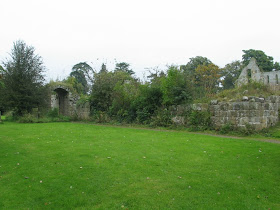Edward II stayed at Jervaulx (which I pronounce as 'Jair-voh', though I'm not sure if that's correct) on 16 and 17 October 1323.
In 1536, the last abbot of Jervaulx, Adam Sedbergh, joined the Pilgrimage of Grace, a massive uprising in Yorkshire and Lincolnshire triggered by the start of the Dissolution. (I think that's the best name for a rebellion I've ever heard.) Sedbergh was hanged, drawn and quartered at Tyburn on 2 June 1537, and as punishment for his actions, Jervaulx was mostly destroyed. Today, it's an atmospheric, romantically overgrown ruin, privately owned but open to the public. (How come some people are lucky enough to own a twelfth-century abbey? Why can't I have one?)
 (Below) The nave of the abbey church, taken from behind the high altar.
(Below) The nave of the abbey church, taken from behind the high altar.(Right) The effigy of Henry Fitzhugh, a great
 benefactor of the abbey, which stands in front of the high altar. He died in 1307, the year Edward II became king.
benefactor of the abbey, which stands in front of the high altar. He died in 1307, the year Edward II became king.
More pics of Jervaulx:














































just passing through, but i love the pictures. thanks for posting those.
ReplyDeleteWhat a beautifully atmospheric place - really romantic. And yes, I would love to own an abbey like that too!
ReplyDeleteWell, Alianore, if you'd been around at the time of Henry VIII, and you'd been a loyal, rich supporter, I'm sure he would have flogged you an abbey or 2:) Seriously, it still looks in good condition considering how long it has been abandonned.
ReplyDeleteThanks, Peter!
ReplyDeleteLady D: it really is an amazing place. Just wish we could have seen it on a nicer day - it was pouring down and freezing.
Anerje: The people who own it now bought it in the 1970s - wish my parents had snapped it up instead! :-)
In medieval England, one could hardly yawn and stretch without grazing an elbow on Church property, it seems. Our ancestors must have been real stinkers to have to buy their way out of deepest purgatory with land and monetary grants to church foundations. Alianore, based on your Yorkshire trip, I dug some more into my de Ros, Scrope, and Percy backgrounds (yes, and Walter Woodpecker, thank you VERY much!), looking for mention of their grants. They were either graciously generous, or scared of hell. Probably the latter! Henry VIII will have some 'splainin' to do about his lead- and gold-recycling projects of the 1530s.
ReplyDeleteIt is the stairs that get me....I wonder how many hands were placed upon the walls as people ascended and descended. How I wish the stones could tell me their stories. Thank you for the wonderful photos. Nature is trying hard to reclaim the abbey, but I see a little of how beautiful it must have been. Must get back to the book I am reading "Building a time machine for dummies"....
ReplyDeleteand Christy, we share the same ancestors...nice to 'meet' you!
Alianore, I can't begin to tell you how much I have enjoyed all of your pictures. My daughter helped me transfer a couple of the Rievaulx pictures into my screen savers so I can see them off and on throughout the day. Such lovely images. I'd also like to thank you for offering a pronunciation guide for the names of these abbeys. And I loved the comment about the name of the rebellion.
ReplyDeleteThank you for the kind words, Linda! I'm really glad you like my pics enough to use as a screensaver. I hope I'm correct in my pronunciation of Jervaulx, but if Rievaulx is 'reevoh' then I think it makes sense.* (The original name was Yorevale, and Rievaulx was Ryevale). I also have lots of pics of Fountains Abbey, which I'll be posting in the next day or two.
ReplyDelete* Sometimes I think that English place names were invented deliberately to catch people out. Who would think that Leominster is 'lemster', Beaulieu is 'byooley', Belvoir is 'beaver' and Loughborough is 'luff-buh-ruh'?? :)
Kate: I understand - I'm obsessed with medieval steps. (I have lots more, taken at Fountains. ;) Please, please hurry up with the 'time travel for dummies' so you can pass the info on to me. ;)
Christy: glad to hear about your research! Our old friend Walter Woodpecker founded 3 abbeys that I know of, so was either generous to the extreme or very scared of what was coming in the afterlife. ;)
Another fantastic thing about your pix is that there's so much lush GREENERY around the ruins. I must have inherited garden-pottering from Edward II, as I enjoy that so much. In southern California, it's been 90-99F and single-digit relative humidity for weeks. No rain for 8 months so far. The only green stuff is cultivated with hose-water, and THAT is covered in dust. It's a micro-mini-break to see the Yorkshire vegetation and imagine myself back there, scrambling amongst the stones, and even soaking up the rain and chill -- not a bad thing for a desert girl.
ReplyDeleteVery true, Christy. I whinge endlessly about the English weather, and the lack of summers these days, but I do love the results - even I'm astonished by how incredibly green England is.
ReplyDeleteI've seen the Border abbeys of Melrose, Dryburgh (LOVED that one) and Jedburgh, but I so want to see yours as well.
ReplyDeleteHope you get to see the great Yorkshire abbeys sometime soon, Gabriele! I'd love to see the ones you mention, too (never been there, though they're not too far from where I grew up).
ReplyDelete